Simulation and Optimization Strategy of Storm Flood Safety Pattern Based on SCS-CN Model
Abstract
:1. Introduction
2. Background of Research
3. Study Area and Data Sources
3.1. Study Area
3.2. Data Sources
| Data | Time | Format | Source | Resolution |
|---|---|---|---|---|
| Landsat satellite data | 2020 | Raster | Geospatial Data Cloud [27] | 30 m × 30 m |
| Digital Elevation Model data | 2018 | Raster | Geospatial Data Cloud [27] | 30 m × 30 m |
| Meteorological data | 1957–2021 | Text | Resource and Environment Science and Data Center [28] | _ |
| Landuse data | 2020 | Raster | Resource and Environment Science and Data Center [29] | 30 m × 30 m |
| Administrative division data | 2015 | Shapefile | Amap [30] | _ |
4. Methodology
4.1. Analysis of Related Concepts
4.1.1. Rain Flood Corridor
4.1.2. Rain Flooded
4.2. Method
4.2.1. SCS Model
4.2.2. Model Parameter Adjustment and Verification
5. Results and Discussion
5.1. Data Preprocessing
5.2. Dividing Watersheds
5.3. Runoff Generation and Runoff Calculation Based on SCS-CN Model
5.3.1. Model Parameter Determination
5.3.2. Rainwater Runoff Calculation
5.3.3. Rainwater Runoff Simulation
5.3.4. Rain Flood Inundation Risk Rating
5.4. Stormwater Safety Optimization Strategy Based on the Concept of Resilient Urban and Rural Areas
6. Conclusions
Author Contributions
Funding
Institutional Review Board Statement
Informed Consent Statement
Conflicts of Interest
References
- The State Council of China. Available online: www.gov.cn/zhengce/2019-05/23/content_5394187.htm (accessed on 25 September 2021).
- People’s Government of Yanhe Tujia Autonomous County. Available online: http://www.yanhe.gov.cn/ztzl/snzzxd/202101/t20210106_66063345.html (accessed on 25 September 2021).
- Fan, J.; Xu, J. Evaluation of vulnerability of regional urban agglomeration based on neural network modeling: A case study of central Yunnan Urban agglomeration. J. Nat. Resour. 2020, 35, 2875–2887. [Google Scholar]
- Kuang, D.; Liao, K.H. Learning from floods: Linking flood experience and flood resilience. J. Environ. Manag. 2020, 271, 111025. [Google Scholar] [CrossRef] [PubMed]
- Liu, T.; Yan, T. Major meteorological disasters and their economic losses in China. J. Nat. Disasters 2011, 20, 90–95. [Google Scholar]
- Liu, F.; Dong, Z.Z. Experimental study on typical parameters of thin layer flow on urban underlying surface under different rainfall conditions. Adv. Water Sci. 2020, 31, 565–574. [Google Scholar]
- Che, W.; Zhao, Y.; Li, J.-Q.; Wang, W.L.; Wang, J.L.; Wang, S.S.; Gong, Y.W. Explanation of sponge city development technical guide: Basic concepts and comprehensive goals. China Water Wastewater 2015, 31, 1–5. [Google Scholar]
- Ran, J.; Nedovic-Budic, Z. Integrating spatial planning and flood risk management: A new conceptual framework for the spatially integrated policy infrastructure. Computers Environ. Urban Syst. 2016, 57, 68–79. [Google Scholar] [CrossRef] [Green Version]
- Yu, K.-J. Security Patterns and Surface Model in Landscape Ecological Planning. Landsc. Urban Plan. 1996, 6, 1–17. [Google Scholar] [CrossRef]
- Yu, K.; Wang, S.; Li, D.; Qiao, Q. The ecological bottom line of Beijing’s urban expansion-basic ecosystem services and its security pattern. Urban Plan. 2010, 34, 19–24. [Google Scholar]
- Liu, Y.; Meng, J.; Zhu, L. Research progress on regional ecological security pattern. Acta Ecol. Sin. 2010, 30, 6980–6989. [Google Scholar]
- Yu, K.; Li, D.; Liu, H. Institute of Landscape Architecture, Peking University. “Reverse Planning” Approach; China Architecture and Architecture Press: Beijing, China, 2005. [Google Scholar]
- Peng, J.; Zhao, H.; Liu, Y.; Du, Y. Regional water security pattern construction: Research progress and conceptual framework. Acta Ecol. Sin. 2016, 36, 3137–3145. [Google Scholar]
- Wen, C.; Dong, W.; Zhang, Q.; He, N.; Li, T. A system dynamics model to simulate the water-energy-food nexus of resource-based regions: A case study in Daqing City, China. Sci. Total Environ. 2022, 806, 150497. [Google Scholar] [CrossRef] [PubMed]
- Su, X.; Shao, W.; Liu, J.; Jiang, Y.; Wang, K. Dynamic Assessment of the Impact of Flood Disaster on Economy and Population under Extreme Rainstorm Events. Remote Sens. 2021, 13, 3924. [Google Scholar] [CrossRef]
- Liu, S.; Lai, S. The progress and enlightenment of foreign rainwater management performance evaluation. South. Archit. 2018, 185, 46–52. [Google Scholar]
- Zhang, Y.; Li, X.; Shao, M.; Tang, L. Research on Greenland Stormwater Management Planning Based on Urban Greenland System Optimization—Taking Tongliao City as an Example. Urban Dev. Res. 2018, 25, 97–102. [Google Scholar]
- Daksiya, V.; Su, H.T.; Chang, Y.H.; Lo, E.Y.M. Incorporating socio-economic effects and uncertain rainfall in flood mitigation decision using MCDA. Nat. Hazards 2017, 87, 515–531. [Google Scholar] [CrossRef]
- Liu, E.; Wang, Q.; Luo, Y. Study on multi-scale storm water management in small mountain towns: A case study of Pengzhou city. Landsc. Archit. 2021, 28, 83–89. [Google Scholar]
- Song, Y.; Yu, K. Landscape planning approach for constructing urban stormwater management system: A case study of Weihai city. Urban Probl. 2007, 8, 64–70. [Google Scholar]
- Guo, R.; Wu, T.; Huang, M. Study on storm flood safety Pattern construction and Planning measures in Harbin. In Urban Planning Society of China, Guiyang Municipal People’s Government. New Normal: Inheritance and Transformation—Proceedings of 2015 China Urban Planning Annual Conference (01 urban Safety and Disaster Prevention Planning); Urban Planning Society of China, Guiyang Municipal Government, Urban Planning Society of China: Shenyang, China, 2015; p. 12. [Google Scholar]
- Li, J.; Zhang, X.; Ren, B.; Kong, W. Study on regional storm flood safety pattern under resilient urban and rural concept: A case study of Fangshan District, Beijing. J. Hebei Univ. Technol. Soc. Sci. Ed. 2021, 13, 79–85. [Google Scholar]
- Candel, J.J.L.; Biesbroek, R. Toward a processual understanding of policy integration. Policy Sci. 2016, 49, 211–231. [Google Scholar] [CrossRef] [Green Version]
- Available online: http://www.harbin.gov.cn/col/col23/index.html (accessed on 10 September 2021).
- Available online: http://www.harbin.gov.cn/col/col38/index.html (accessed on 10 September 2021).
- Available online: http://xxgk.harbin.gov.cn/col/col11578/index.html (accessed on 10 September 2021).
- Geospatial Data Cloud. Available online: http://www.gscloud.cn/ (accessed on 20 September 2021).
- Resource and Environment Science and Data Center. Available online: https://www.resdc.cn/data.aspx?DATAID=253 (accessed on 17 August 2021).
- Resource and Environment Science and Data Center. Available online: https://www.resdc.cn/ (accessed on 17 August 2021).
- Available online: https://lbs.amap.com (accessed on 12 August 2021).
- Gholami, V.; Khaleghi, M.R.; Salimi, E.T. Groundwater quality modeling using self-organizing map (SOM) and geographic information system (GIS) on the Caspian southern coasts. J. Mount. Sci. 2020, 17, 35–39. [Google Scholar] [CrossRef]
- Quintero, G.; Olga Patricia y Thomas, B.; Enrique, J. Public Policy Networks: Analysis Of Flood-Risk Management In The High Valley Of Cauca River, Colombia. Investig. Geográficas 2018, n.97, 00010. [Google Scholar]
- Luo, Y.; Wu, J. Linking the minimum spanning tree and edge betweenness to understand arterial corridors in an ecological network. Landsc. Ecol. 2021, 36, 1549–1565. [Google Scholar] [CrossRef]
- Jiang, X.; Yang, L.; Tatano, H. Assessing spatial flood risk from multiple flood sources in a small river basin: A method based on multivariate design rainfall. Water 2019, 11, 1031. [Google Scholar] [CrossRef] [Green Version]
- Darabi, H.; Haghighi, A.T.; Rahmati, O.; Shahrood, A.J.; Rouzbeh, S.; Pradhan, B.; Bui, D.T. A hybridized model based on neural network and swarm intelligence-grey wolf algorithm for spatial prediction of urban flood-inundation. J. Hydrol. 2021, 603, 126854. [Google Scholar] [CrossRef]
- Nishimura, S.; Takeshita, Y.; Nishiyama, S.; Suzuki, S.; Shibata, T.; Shuku, T.; Komatsu, M.; Kim, B. Disaster report of 2018 July heavy rain for geo-structures and slopes in Okayama. Soils Found. 2020, 60, 300–314. [Google Scholar] [CrossRef]
- Zhao, W.; Liu, Y.; Daryanto, S.; Fu, B.; Wang, S.; Liu, Y. Metacoupling supply and demand for soil conservation service. Curr. Opin. Environ. Sustain. 2018, 33, 136–141. [Google Scholar] [CrossRef]
- Liao, G.; Lin, H.; Wang, Y. Urban Resilience and Flood bearing theory—Another basis of planning practice. Urban Plan. Int. 2015, 2, 36–47. [Google Scholar]
- Shrestha, S.; Cui, S.; Xu, L.; Wang, L.; Manandhar, B.; Ding, S. Impact of Land Use Change Due to Urbanisation on Surface Runoff Using GIS-Based SCS–CN Method: A Case Study of Xiamen City, China. Land 2021, 10, 839. [Google Scholar] [CrossRef]
- Lin, K.R.; Wei, X.P.; Huang, S.X.; HE, Y. Application of SWAT model in Dongjiang river basin. J. China Hydrol. 2013, 33, 32–36. [Google Scholar]
- United States Department of Agriculture. National Engineering Handbook; Natural Resources Conservation Service: Washington, DC, USA, 2015. Available online: https://www.nrcs.usda.gov/wps/portal/nrcs/detailfull/national/water/?cid=stelprdb1043063 (accessed on 25 August 2021).
- Zhang, D.; Yan, D.; Wang, Y.; Lu, F.; Liu, S. Research progress in urban waterlogging disaster risk assessment and comprehensive response. J. Catastrophology 2014, 29, 144–149. [Google Scholar]
- Popova, E.; Vousden, D.; Sauer, W.H.H.; Mohammed, E.Y.; Allain, V.; Downey-Breedt, N.; Fletcher, R.; Gjerde, K.M.; Halpin, P.N.; Kelly, S.; et al. Ecological connectivity between the areas beyond national jurisdiction and coastal waters: Safeguarding interests of coastal communities in developing countries. Mar. Policy 2019, 104, 90–102. [Google Scholar] [CrossRef]
- Cun, C.; Zhang, W.; Che, W.; Sun, H. Review of urban drainage and stormwater management in ancient China. Landsc. Urban Plan. 2019, 190, 103600. [Google Scholar] [CrossRef]
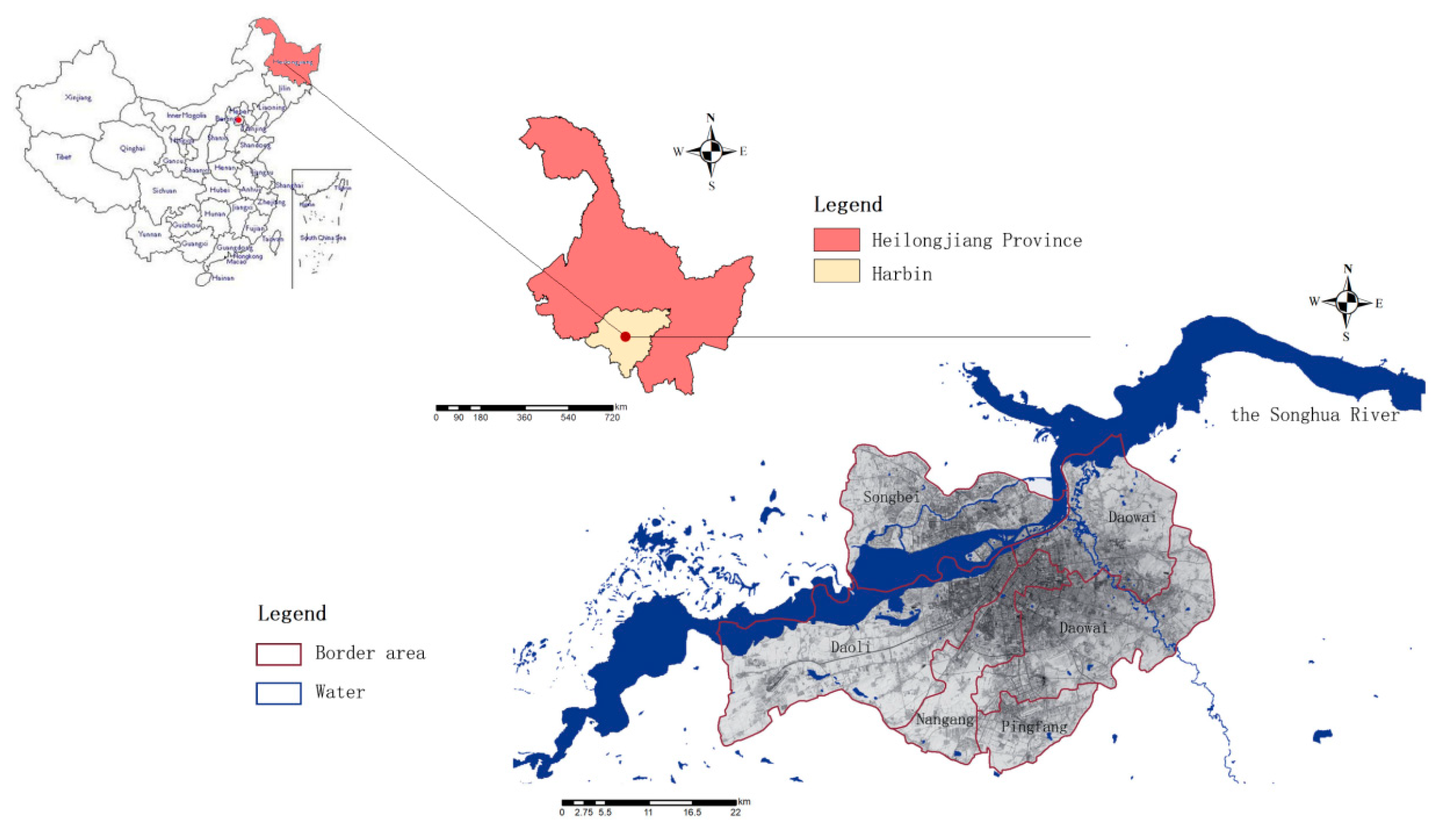
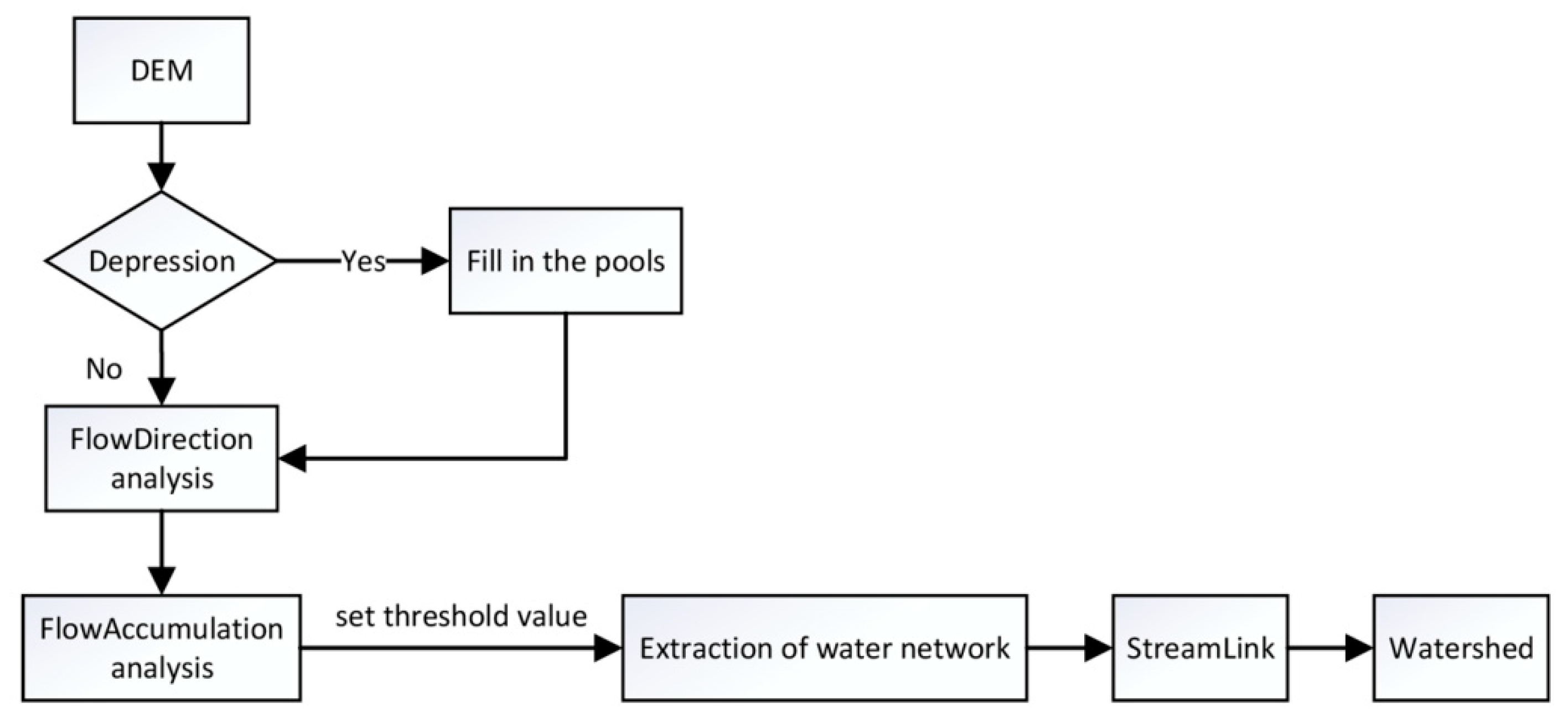
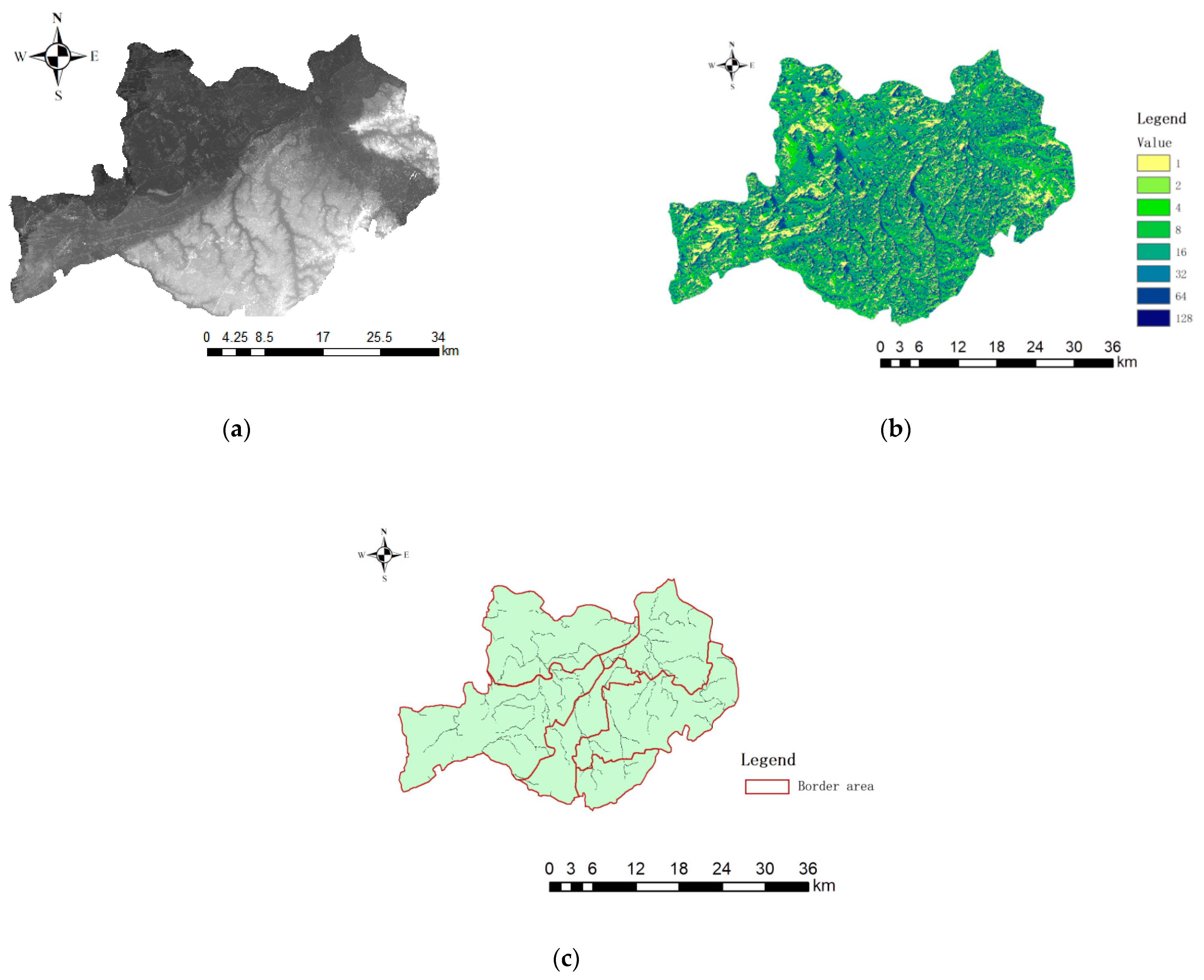
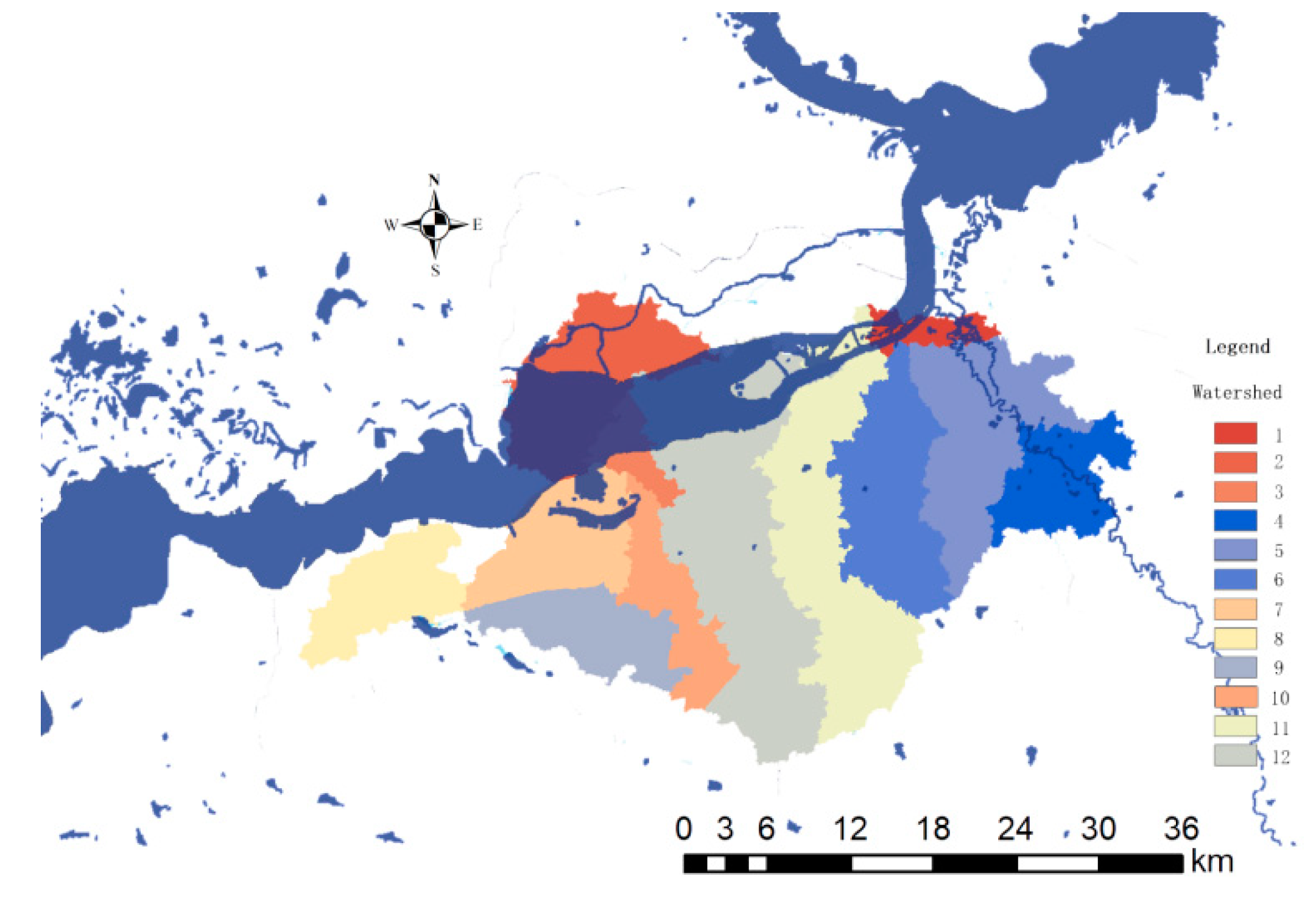
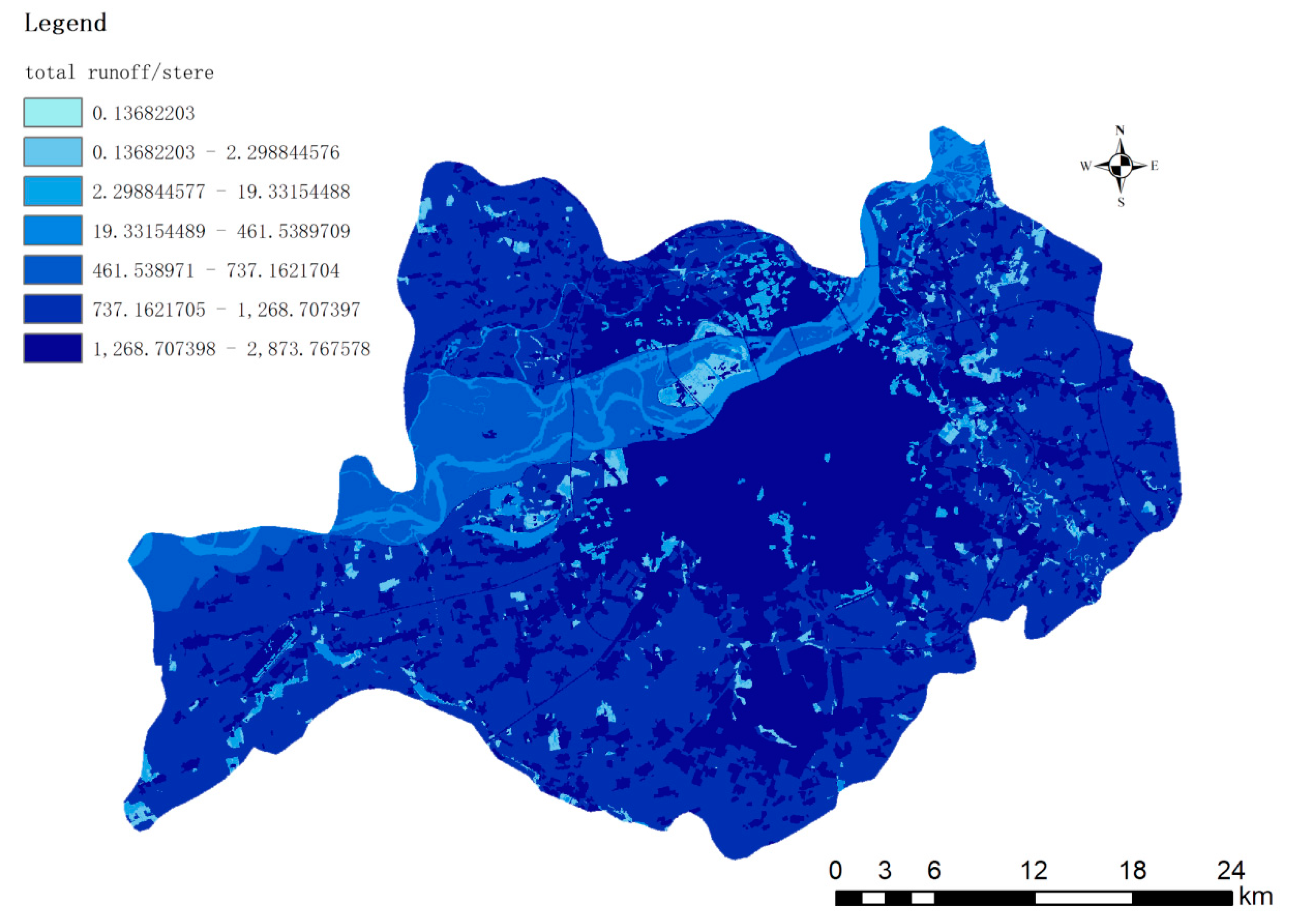
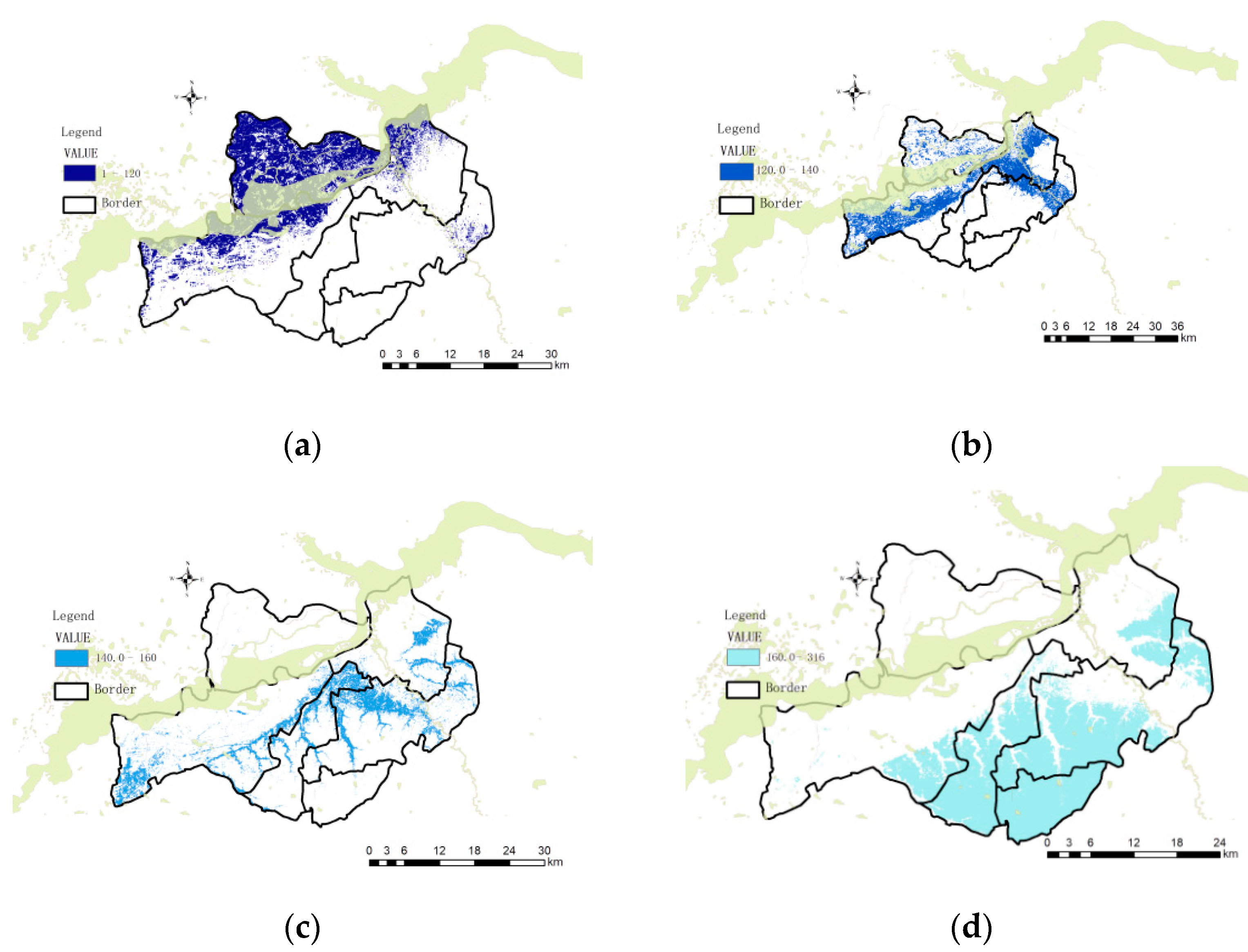
| No. | Type of Underlying Surface | CN Value | Potential Infiltration (S)/mm | Direct Surface Runoff (Q)/mm |
|---|---|---|---|---|
| 1 | Farmland | 80 | 63.5 | 13.80 |
| 2 | Forest | 56 | 199.57 | 0.49 |
| 3 | Grass | 66 | 130.85 | 3.67 |
| 4 | Water | 100 | 0 | 50 |
| 5 | Artificial surface | 98 | 5.18 | 44.28 |
| 6 | Bare land | 86 | 41.35 | 20.96 |
| No. | Number of Patches | Area/km2 | Percent of Total Area/% | Average Runoff (Q/mm) | Total Runoff/m3 | Runoff Percent of Every Land Use Type/% |
|---|---|---|---|---|---|---|
| 1 | 251 | 19.37 | 1.78% | 30.19 | 584,780 | 1.77% |
| 2 | 419 | 106.44 | 9.79% | 36.07 | 3,839,290 | 11.6% |
| 3 | 122 | 22.20 | 2.04% | 39.94 | 886,668 | 2.68% |
| 4 | 412 | 60.54 | 5.57% | 20.24 | 1,225,330 | 3.7% |
| 5 | 1278 | 116.26 | 10.7% | 24.51 | 2,849,533 | 8.61% |
| 6 | 342 | 104.52 | 9.62% | 35.93 | 3,755,404 | 11.34% |
| 7 | 671 | 76.82 | 7.07% | 23.38 | 1,796,052 | 5.43% |
| 8 | 337 | 67.41 | 6.20% | 19.68 | 1,326,629 | 4.01% |
| 9 | 162 | 65.59 | 6.04% | 21.12 | 1,385,260 | 4.18% |
| 10 | 202 | 54.45 | 5.01% | 23.82 | 1,296,999 | 3.92% |
| 11 | 336 | 161.85 | 14.89% | 35.37 | 5,724,634 | 17.3% |
| 12 | 971 | 231.26 | 21.29% | 36.45 | 8,429,427 | 25.47% |
| Total | 5503 | 1086.71 | 100% | 346.7 | 33,100,006 | 100% |
Publisher’s Note: MDPI stays neutral with regard to jurisdictional claims in published maps and institutional affiliations. |
© 2022 by the authors. Licensee MDPI, Basel, Switzerland. This article is an open access article distributed under the terms and conditions of the Creative Commons Attribution (CC BY) license (https://creativecommons.org/licenses/by/4.0/).
Share and Cite
Cai, X.; Xu, D. Simulation and Optimization Strategy of Storm Flood Safety Pattern Based on SCS-CN Model. Int. J. Environ. Res. Public Health 2022, 19, 698. https://doi.org/10.3390/ijerph19020698
Cai X, Xu D. Simulation and Optimization Strategy of Storm Flood Safety Pattern Based on SCS-CN Model. International Journal of Environmental Research and Public Health. 2022; 19(2):698. https://doi.org/10.3390/ijerph19020698
Chicago/Turabian StyleCai, Xinhong, and Dawei Xu. 2022. "Simulation and Optimization Strategy of Storm Flood Safety Pattern Based on SCS-CN Model" International Journal of Environmental Research and Public Health 19, no. 2: 698. https://doi.org/10.3390/ijerph19020698
APA StyleCai, X., & Xu, D. (2022). Simulation and Optimization Strategy of Storm Flood Safety Pattern Based on SCS-CN Model. International Journal of Environmental Research and Public Health, 19(2), 698. https://doi.org/10.3390/ijerph19020698






